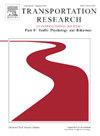Evaluation of carsickness countermeasures in a test track study
IF 3.5
2区 工程技术
Q1 PSYCHOLOGY, APPLIED
Transportation Research Part F-Traffic Psychology and Behaviour
Pub Date : 2025-05-10
DOI:10.1016/j.trf.2025.04.028
引用次数: 0
Abstract
Carsickness is an inconvenience to many people traveling in a car and might become even more problematic with increasing vehicle automation. As part of a user study, several countermeasures were developed and evaluated. A modified test car with participants seated as passengers was driven around a standardized, enclosed test track. A reading task was employed to elicit carsickness. The countermeasures included (1) visual cues about upcoming vehicle motions, (2) so-called non-read zones on demanding parts of the test track during which participants were supposed not to read and finally (3) listening to an audiobook. Several measures were employed to quantify participants’ state of distress. The continuously asked Misery Scale ratings revealed a steady rise of carsickness levels in the baseline condition without any countermeasure (p < 0.001). The countermeasure condition (1) revealed to systematically lower the carsickness level (p < 0.001). Though with a moderate effect size (η2 = 0.074). The countermeasures (2) and (3) both decreased the Misery Scale ratings much more distinctively (η2 = 0.369). The obtained results show that visual cues are helpful in decreasing carsickness. However, switching to the audio channel or simply stopping the reading task during demanding road stretches is much more helpful.
试验轨道晕车对策的评价
晕车对许多坐车的人来说是一种不便,随着汽车自动化程度的提高,晕车问题可能会变得更加严重。作为用户研究的一部分,制定和评估了若干对策。一辆改装过的测试车在标准化的封闭测试轨道上行驶,参与者坐在车上当乘客。一项阅读任务被用来诱发晕车。这些对策包括(1)关于即将到来的车辆运动的视觉提示,(2)在测试轨道的高要求部分设置所谓的非阅读区,在此期间参与者不应该阅读,最后(3)听有声读物。采用了几种测量方法来量化参与者的痛苦状态。连续询问的痛苦量表评分显示,在没有任何对策的情况下,晕车水平在基线条件下稳步上升(p <;0.001)。系统降低晕车水平的对策条件(1)0.001)。虽然具有中等效应大小(η2 = 0.074)。对策(2)和对策(3)均显著降低了痛苦量表评分(η2 = 0.369)。结果表明,视觉提示有助于减少晕车。然而,切换到音频频道或简单地停止阅读任务在苛刻的道路延伸更有帮助。
本文章由计算机程序翻译,如有差异,请以英文原文为准。
求助全文
约1分钟内获得全文
求助全文
来源期刊
CiteScore
7.60
自引率
14.60%
发文量
239
审稿时长
71 days
期刊介绍:
Transportation Research Part F: Traffic Psychology and Behaviour focuses on the behavioural and psychological aspects of traffic and transport. The aim of the journal is to enhance theory development, improve the quality of empirical studies and to stimulate the application of research findings in practice. TRF provides a focus and a means of communication for the considerable amount of research activities that are now being carried out in this field. The journal provides a forum for transportation researchers, psychologists, ergonomists, engineers and policy-makers with an interest in traffic and transport psychology.

 求助内容:
求助内容: 应助结果提醒方式:
应助结果提醒方式:


